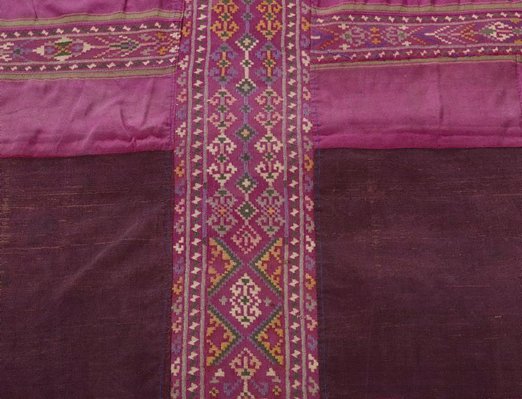

-
Details
- Other Title
- Tube skirt ('Malong landap')
- Place where the work was made
-
Lanao del Sur
→
Mindanao
→
Philippines
- Cultural origin
- Maranao
- Date
- 20th century
- Media category
- Textile
- Materials used
- silk; with decorative tapestry [langkit]
- Dimensions
- 158.0 x 157.0 cm
- Credit
- Gift of Dr John Yu and Dr George Soutter 2005
- Location
- Not on display
- Accession number
- 214.2005
- Copyright
- Artist information
-
Maranao
Works in the collection
- Share
-
-
About
Mindanao, in the southern Philippines, consists of a large landmass and series of smaller islands that cascade across the Sulu Sea towards Malaysia. Its east coast and interior is home to a number of different indigenous people whose textile traditions share technical and material features, including the use of abaca fibre, ikat dying methods and the use of backstrap looms. Although technically similar, the textiles display patterns and motifs designed to meet social or spiritual functions specific to each community. In some cases motifs reflect a deep respect for local flora and fauna and are believed to act as conduits to the divine. Other textiles are designed as ceremonial gifts on occasions such as marriage, or are hung to designate spaces of spiritual importance.
Much of the west coast and archipelagic parts of Mindanao are home to Muslim communities who have strong links with early seafaring Sultanates that resisted Spanish imperialism. They share cultural and religious practises with neighbours in Malaysia, Brunei and Indonesia and are renowned for their architectural woodcarvings.
Over the centuries, international and local trade introduced new materials and modes of production. This led Mindanao’s artisans to abandon some materials and adopt others to create innovative textiles and crafts for exchange between the region’s diverse communities.
The Maranao are one of the Muslim groups of Mindanao. Both men and women wear tubular garments called malong. This type of garment is used in a number of different ways, from skirt to gown to baby carrier, and even sleeping blanket.
The two main types of Maranao tubular garments are the 'malong landap', worn by men and women, and the more complex and decorative malong a andon worn exclusively by women. While the 'malong' a andon is typified by beautiful supplementary weft and ikat designs, the 'malong landap' is characterised by large expanses of 'landap' or ‘pure’ colour interrupted by tapestry bands known as 'langkit'. The 'langkit' that run vertically and horizontally across the 'malong landap' add decoration and serve to join three individually woven pieces of fabric into a skirt. The band that runs vertically down the centre of the 'malong landap' is called the 'lakban'. The two narrower horizontal bands are called 'tobrian'. The geometric designs of the 'langkit' are similar to the curvilinear designs of Maranao woodcarving and, like the woodcarvings, are known as 'okir'.
The colour scheme for 'malong landap' usually combines large fields of purple, magenta or green silk bordered and joined by purple, yellow or green 'langkit'. 'Malong' that exhibit large fields of bright yellow silk enhanced by dark purple or green 'langkit' are even more unusual and highly prized. While cotton and abaca are materials produced locally, silk was always imported, usually from China. China was perhaps also the cultural origin for the significance given to yellow as a symbol of high status.
-
Provenance
John Yu, 1970s-2005, Sydney/New South Wales/Australia, purchased mid-1970s from an antique shop in Mabini st., Manila, Philippines. Donated to the Art Gallery of New South Wales, Sydney, 2005.




